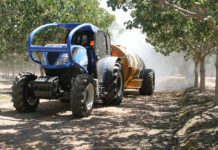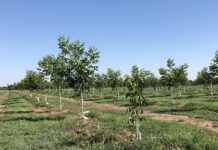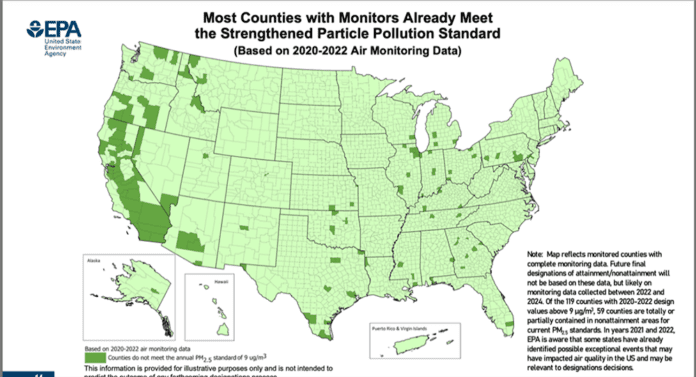
The end of the fireplace in the San Joaquin Valley is closer than ever, and possibly even the end of the combustion engine. With the Federal Environmental Protection Agency’s (EPA) adoption of a lower PM2.5 National Ambient Air Quality Standard (NAAQS), these two sources of PM2.5 emissions will most likely have to cease to have any chance of meeting this incredibly challenging new standard. Is that really going to happen? The end of my fireplace? Will we only have electric cars and trucks in the San Joaquin Valley? Will more fugitive dust rules and a mandatory tractor replacement regulation follow? These are all great questions in response to EPA lowering the PM2.5 NAAQS from 12 µg/m3 to 9 µg/m3. I know what you are thinking: C’mon, is it really that serious? Undeniably.
Let’s look at the history of the particulate matter standard to give us some context. The first EPA NAAQS for particulate was total suspended particulate or TSP. This is dust, typically what you can actually see. Then after evidence started to appear that the real health concern was due to small particles that were getting past the body’s defense mechanisms and into the lungs, EPA changed the standard to address particulate matter of a size less than 10 µg or PM10.
At the same time, they lowered the actual level as well. A few years later, additional health science pointed toward even smaller particulates or ultrafine particles known as PM2.5 and subsequently EPA changed the standard to particulate matter of a size less than 2.5 microns. PM2.5 is equivalent to 1/28th the diameter of a human hair. For the most part, PM2.5 is made up of smoke, soot or secondary particulates made up of ammonium nitrate or ammonium sulfate. Science has demonstrated dust, or geologic material, makes up a very small percentage of what we find in PM2.5. Typically, dust is larger than PM2.5; however, armed with this new health science and immense pressure from environmental justice activists, on Feb. 7, 2024, EPA strengthened the National Ambient Air Quality Standards for Particulate Matter (PM NAAQS). EPA claims particle or soot pollution is one of the most dangerous forms of air pollution, and an extensive body of science links it to a range of serious and sometimes deadly illnesses. EPA is setting the level of the primary (health based) annual PM2.5 standard at 9.0 µg per cubic meter, a level they believe is consistent with the available health science.
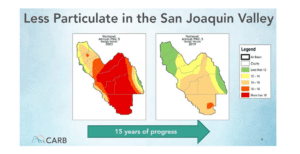
In response, activists are acting like air control agencies in California and the Federal EPA haven’t done anything to clean up our air. That simply isn’t true. In Figure 1, for the San Joaquin Valley, you can see how air quality has improved dramatically. Unfortunately, much like how Lucy used to pull the football away just as Charlie Brown was going to kick it, the Federal EPA has once again moved the goal posts on us by “lowering the standard.”
This new standard is so restrictive 24 states filed a lawsuit on the very day EPA announced the new standard. The 24 states suing EPA over the rule are: Alabama, Alaska, Arkansas, Florida, Georgia, Idaho, Indiana, Iowa, Kansas, Kentucky, Louisiana, Mississippi, Missouri, Montana, Nebraska, North Dakota, Ohio, Oklahoma, South Carolina, South Dakota, Tennessee, Utah, West Virginia and Wyoming. These same states urged the Biden administration before the rule was promulgated not to proceed with tougher standards.
“Petitioners will show that the final rule exceeds the agency’s statutory authority and otherwise is arbitrary, capricious, an abuse of discretion, and not in accordance with law. Petitioners thus ask that this Court declare unlawful and vacate the agency’s final action,” the States said in their suit.
Most believe the new standard will place many more areas into “nonattainment,” and as a result these areas must develop state implementation plans outlining measures to attain the limit and must impose tougher permitting requirements on new and modified industrial facilities.
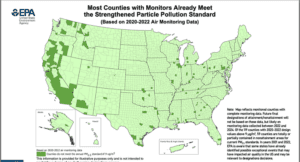
Meeting the New Standard
So, what will California have to do to try and meet this new standard? First, according to data from EPA collected from 2020-22, most California counties will be in nonattainment, including remote mountain counties like Siskiyou, Shasta, Alpine, Mendocino and Mono Counties. For sure, all counties in the Sacramento and San Joaquin Valleys do not meet the new standard based on this data. With that in mind, California and the air districts in these non-attainment areas will have to be aggressive in implementing new emission controls and riding the coattails of the California Air Resources Board (CARB). CARB will be looking to tighten combustion emissions, although most of that is already being carried out in their Advanced Clean Truck, Advanced Clean Fleet and Zero Emission Forklift Regulations. At the air district level, pressure will be put on to tighten fireplace regulations, if not ban them altogether, and look at controlling fugitive dust even more.
Another focal point will be charbroilers at restaurants like those found at Burger King or El Pollo Loco. For agricultural interests, there have already been discussions on addressing fugitive dust from fallowed fields due to SGMA and going as far as to consider mandating low-dust tree nut harvesting equipment. The Association has fought that mandate as the science tells us PM2.5 is a very miniscule fraction of the dust that comes from windblown dust or tree nut harvesting operations. A mandatory replacement regulation would be expensive and would not make much of an improvement in air quality. But this is California, and this administration has let activists dictate policy, so nothing would be a surprise at this point, no matter how impactful. Even if it eliminates the very jobs of the people the activists claim to represent.
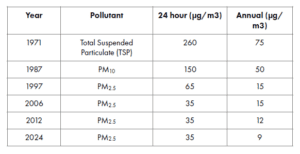
This new air quality standard is precedent-setting. It is almost to background levels, and probably impossible to meet. This is going to be a long, hard ride. Agriculture will have to stand strong and make sure we are not completely driven out of farming. But with standards this low, maybe California will have some friends to help push back.



